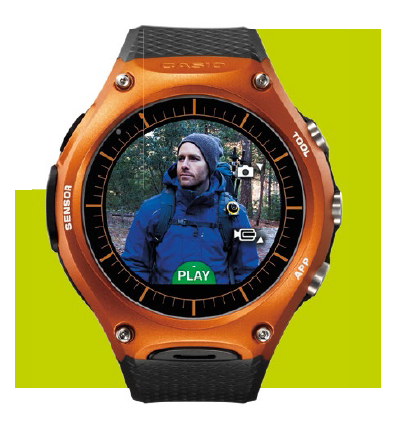Casio WSD-F10 by Zachary Chan


Casio WSD-F10 by Zachary Chan

AT A GLANCE
OPERATING SYSTEM Android Wear
DISPLAY 1.32-inch dual layer touchscreen 320x300 pixels color TFT, Monochrome LCD
SENSORS Pressure, magnetic, gyrometer, accelerometer
RESISTANCE MIL-STD-810G, 50m water resistance
PRICE $699
Casio first made waves earlier this year at CES 2016, when they announced their Smart Outdoor Watch, a marriage of Casio’s G-Shock design mentality, Protrek outdoors functionality and Android Wear. The WSD-F10 was promising in that it would be the one to finally get smartwatches out of their stifled comfort zone and start doing something adventurous.
Yes, if you look at the WSD-F10 from the perspective of a tech product, it is just another Android Wear device. It is compatible with all Android Wear apps on the Play Store and features the standard baked-in Google apps and OK Google voice functionality. Here’s where it gets interesting.
First things first, the WSD-F10 is huge. Think G-Shock Master of G series in terms of size. It will definitely not fit dainty hands. It is however, surprisingly lightweight at just 93g. The design of the WSD-F10 is also decidedly unassuming, with a smooth case that lacks the signature raised ridges and chucky buttons of its G-Shock brethren. Because of this though, you may mistakenly think that the WSD-F10 isn’t as rugged as a G-Shock. You’d be wrong. The WSD-F10 is waterproof up to 50m and conforms to MIL-STD- 810G of the US military standards for environmental performance.
On the right side of the case, three buttons serve as shortcuts to launch the WSD-F10’s dedicated tools, an app launcher and power/home button. A magnetic charging port and sensor array are on the left and the bottom is a mic input.
The screen has a capacitive touch LCD, but Casio cleverly implements a dual-layer display with a color TFT screen and a monochrome LCD on top of each other. While the 1.32-inch, 320x300 pixels display isn’t the most vivid we’ve seen and it has the same “flat tire” attribute like the Moto 360, this is quite an ingenious method to save battery. There are a few options on how the watch switches between the two displays, which can give you anywhere between 1.5 to 30 days of battery life on a single charge.
With the color display set to Alwayson, I’d have to charge the watch nightly. Turning off the Always-on option puts the watch into monochrome mode when idle and I’ve managed to extend my time between charges to nearly three days. There is also a Timepiece mode, which turns off Android Wear completely, making the WSD-F10 function as a standard monochrome digital watch. Why would you buy a smartwatch and turn off the smarts? Well, if you’re trekking somewhere off the grid, you’d at least have a functioning watch for up to a month.
As an outdoors companion, the WSD-F10 comes with a range of sensors and tools for trekking, cycling and fishing. It has a built-in digital compass, barometer and altimeter, but disappointingly lacks a GPS sensor. These tools can be accessed directly on the watch using the dedicated Tool button, but to customize their options, you’ll need the companion Moment Setter+ app. The app can also be used to personalize notifications based on activity, such as hourly air pressure alerts or a reminder when you reach a point on interest in your trek.
Right now, Moment Setter+ only acts as a control center for the WSD-F10. I’d love to see additional functionality such as detailed activity logging and analytics to fully make use of the fact that I’ve got a computer on my wrist. Also, at time of writing, only the Android version of the app is released. While the watch can be paired with an iPhone, Android Wear and Casio functionality will be severely limited.
One last little known feature of the WSD-F10 is its built-in integration with Casio’s EX-FR100 outdoors camera (and only this one particular model). If you remember, the EX-FR100 is a modular camera with a detachable lens and controller. The WSD-F10 can natively connect and control the EX-FR100 lens unit. The watch acts as a remote viewfinder and shutter, can toggle between photo and video recording, plus a few additional settings such as interval, continuous and selftimer shooting modes. While not as advanced as the proper EX-FR100 controller, it is perfectly functional and fits into the EX-FR100’s ethos of carefree lifestyle photography.
The WSD-F10’s asking price is $699, which feels reasonable considering Casio’s flagship Protrek and G-Shock watches with similar Triple Sensor features retail in the same range or higher. Casio is also bundling the WSD-F10 with the full EX-FR100 camera set at $1,398 or just the lens at $1,128.
CONCLUSION
One of the more ambitious Android Wear devices out there with plenty of realworld potential, if a little rough around the edges.



























